Behind the Brush: The Stories and Meanings of Frida Kahlo’s Greatest Paintings
- 1. Self-Portrait With Thorn Necklace And Hummingbird
- 2. The Two Fridas
- 3. Self Portrait With Cropped Hair
- 4. Self-Portrait On The Borderline Between Mexico And The UnitedStates
- 5. Henry Ford Hospital
- 6. My Grandparents, My Parents, And I (Family Tree)
- 7. The Broken Column
- 8. The Bus
- 9. Self-Portrait As A Tehuana
- 10. The Wounded Deer
Frida Kahlo, a Mexican artist renowned for her deeply personal and symbolic paintings, stands as a pivotal figure in 20th-century art. Born in 1907 in Coyoacán, Mexico, Kahlo's work is a unique blend of realism, symbolism, and surrealism, drawing heavily on her own life experiences, physical and emotional pain, and her rich Mexican heritage. Her art explores themes of identity, post-colonialism, gender, class, and race in Mexican society. Despite facing numerous health challenges throughout her life, including polio as a child and a severe bus accident at the age of 18, Kahlo's resilience and strength are evident in her vibrant, often haunting self-portraits. Today, she is celebrated not only for her innovative artistry but also for her activism, distinctive style, and unapologetic expression of female experience.
In this article, we will delve into the stories and symbolism behind 10 of Frida Kahlo's most famous paintings, exploring the depth and breadth of her extraordinary body of work.
1. Self-Portrait With Thorn Necklace And Hummingbird
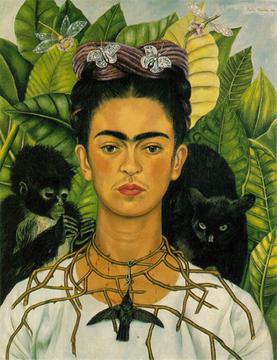
Frida Kahlo "Self-portrait With Thorn Necklace And Hummingbird" (1940)
"Self-Portrait with Thorn Necklace and Hummingbird" (1940) is one of Frida Kahlo's most evocative and symbolically rich paintings. Created during a period of intense personal turmoil following her divorce from fellow artist Diego Rivera, this self-portrait captures the essence of Kahlo's pain and resilience. In the painting, Kahlo depicts herself in a frontal, stoic pose, surrounded by a dense jungle background that reflects her deep connection with Mexican identity and its indigenous roots.
The thorn necklace, biting into her neck and drawing blood, serves as a powerful symbol of her suffering and the emotional wounds inflicted by her tumultuous relationship with Rivera. The hummingbird, traditionally seen as a symbol of love and freedom in Mexican culture, hangs lifelessly, adding to the painting's complex narrative of love, pain, and personal loss. Interestingly, the black cat on her shoulder and the monkey on her other side are both considered personal pets and symbolic elements, representing bad luck and protective forces, respectively.
Kahlo's use of vivid colors and meticulous attention to detail, combined with the incorporation of Christian iconography and Mexican folk art, creates a compelling visual language that communicates her inner turmoil and strength. "Self-Portrait with Thorn Necklace and Hummingbird" is not only a testament to Kahlo's unparalleled ability to convey raw emotion and symbolic depth but also stands as a poignant reflection on the human condition, making it one of her most studied and revered works.
2. The Two Fridas
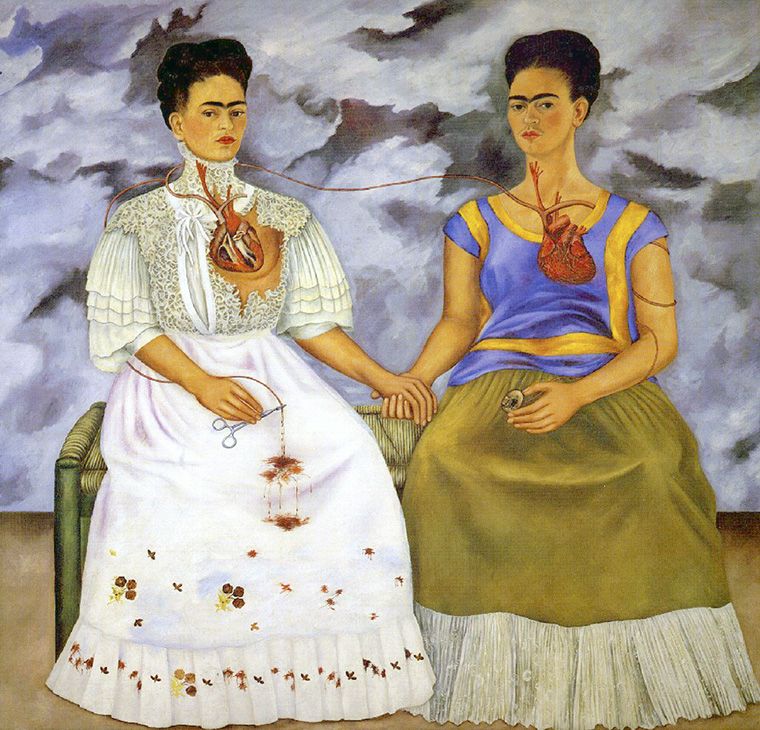
Frida Kahlo "The Two Fridas" (1939)
"The Two Fridas" (1939) is a striking double self-portrait that ranks among Frida Kahlo's most celebrated works, offering profound insight into her inner turmoil and duality of identity. Painted shortly after her divorce from Diego Rivera, this large canvas depicts two distinct versions of Kahlo seated side by side, holding hands, yet visually and emotionally contrasting.
One Frida is dressed in a European-style Victorian gown, representing the Frida that Rivera once loved, while the other wears a Tehuana costume, embracing her Mexican heritage and independent spirit. The hearts of the two Fridas are exposed, with the traditional Frida's heart broken and the indigenous Frida's heart whole, yet both are connected by a vein that the traditional Frida cuts with scissors, symbolizing the pain of her failed marriage and her struggle with identity.
The stormy sky in the background further intensifies the painting's emotional charge, reflecting Kahlo's turmoil and loneliness. "The Two Fridas" is not only a powerful exploration of personal and cultural identity but also a vivid portrayal of Kahlo's resilience, creativity, and the complexity of human emotion. This masterpiece remains a poignant testament to her artistic genius and her enduring influence on modern art.
3. Self Portrait With Cropped Hair

Frida Kahlo "Self Portrait With Cropped Hair" (1940)
"Self Portrait with Cropped Hair" (1940) marks a significant departure in Frida Kahlo's series of self-portraits. Painted shortly after her divorce from Diego Rivera, this work is a bold statement of self-reinvention and defiance against traditional gender roles. Kahlo depicts herself in the picture seated in a huge, empty room, dressed in an oversized men's suit that is probably Rivera's, and with a radically short haircut. These features contrast sharply with her long hair and feminine clothing that are characteristic of her earlier works.
With scissors in hand and locks of her shorn hair scattered around her, Kahlo challenges societal expectations of female beauty and behavior, symbolizing her liberation from her tumultuous marriage and rejecting the conventional symbols of femininity that Rivera adored. The musical notes and the song lyrics in the background, translating to "Look, if I loved you it was because of your hair. Now that you are without hair, I don't love you anymore," further emphasize the theme of rejection and personal transformation.
"Self Portrait with Cropped Hair" stands as a powerful testament to Kahlo's resilience, showcasing her ability to use personal pain as a catalyst for artistic expression and identity exploration. This painting is celebrated for its raw honesty, symbolic depth, and its groundbreaking approach to gender, identity, and self-perception.
4. Self-Portrait On The Borderline Between Mexico And The UnitedStates
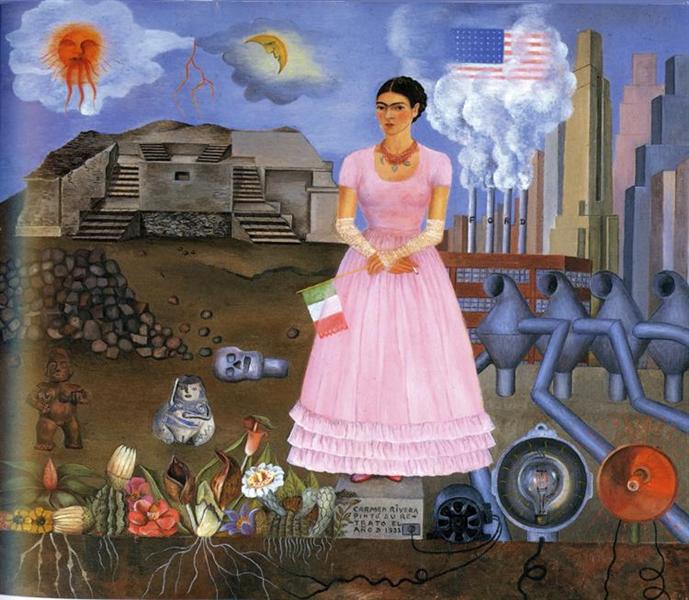
Frida Kahlo "Self-portrait On The Borderline Between Mexico And The United States" (1932)
"Self-Portrait on the Borderline Between Mexico and the United States" (1932) is one of Kahlo's most politically charged and autobiographical works, painted during her stay in Detroit while Diego Rivera was commissioned for the Detroit Industry Murals. This painting vividly captures the contrasts and conflicts Kahlo felt between her beloved homeland, Mexico, and the industrialized society of the United States, which she found alienating and overwhelming.
In the painting, Kahlo stands on a pedestal, straddling the border between two vastly different worlds: the industrial landscape of the United States, characterized by smokestacks and factory buildings, and the fertile soil of Mexico, populated with traditional symbols, such as a sun, a moon, and pre-Columbian idols. Clutching the Mexican flag, Kahlo's stance is both defiant and proud, asserting her Mexican identity and critique of American capitalism.
The painting is rich in symbolism, contrasting the organic and cultural richness of Mexico with the mechanical coldness of the United States. "Self-Portrait on the Borderline Between Mexico and the United States" is a poignant commentary on national identity, cultural heritage, and the personal struggle of navigating between two worlds, showcasing Kahlo's deep engagement with social and political issues.
5. Henry Ford Hospital
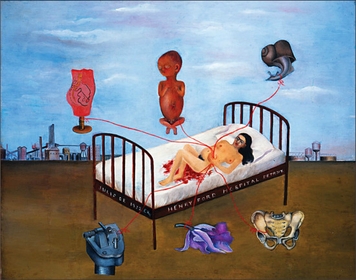
Frida Kahlo "Henry Ford Hospital" (1932)
"Henry Ford Hospital" (1932) is another deeply personal and raw depiction of Frida Kahlo's grief following a miscarriage in Detroit. Lying on a hospital bed against a stark, industrial backdrop, Kahlo portrays her physical and emotional pain with brutal honesty. Surrounding her are symbolic objects tethered to her by red ribbons, resembling umbilical cords, which represent various aspects of her loss and suffering, including a fetus, a snail symbolizing the slow agony of the miscarriage, and a pelvic bone, referencing her physical pain and infertility.
This work is notable for its direct and unflinching portrayal of female experience, a subject often considered taboo. Kahlo's use of surreal imagery to convey her personal tragedy and the isolation she felt in a foreign land is both haunting and revolutionary. "Henry Ford Hospital" stands as a powerful testament to her strength in confronting and depicting her vulnerabilities, making it a seminal piece in her exploration of identity, loss, and resilience.
6. My Grandparents, My Parents, And I (Family Tree)

Frida Kahlo "My Grandparents, My Parents, And I (Family Tree)" (1936)
"My Grandparents, My Parents, and I (Family Tree)" (1936) is a poignant exploration of Frida Kahlo's lineage and identity, weaving together the personal and the ancestral. In this painting, Kahlo stands on the courtyard of her beloved Blue House, physically connecting her Mexican heritage and her own existence through the depiction of a genealogical tree. The roots reach towards her grandparents, symbolizing her deep connection to her mixed European and indigenous Mexican heritage. Above, her parents are depicted within a landscape that merges elements of Mexico and Europe, highlighting the cultural confluence that defines her identity. Kahlo's inclusion of herself as a child, holding the ribbon that binds the family together, emphasizes the continuity and influence of her ancestors in her life and work.
7. The Broken Column

Frida Kahlo "The Broken Column" (1944)
"The Broken Column" (1944) stands as one of Frida Kahlo's most striking and emblematic works, delving deep into themes of pain, resilience, and isolation. In this visceral self-portrait, Kahlo depicts herself with her spine replaced by a shattered Ionic column, symbolizing the physical agony and emotional distress caused by a severe bus accident in her youth. Her body is pierced with nails, further accentuating her suffering, while her face, though tear-streaked, exudes a stoic resilience.
Kahlo is set against a barren, cracked landscape, mirroring her fractured spine and the sense of isolation her injuries imposed upon her. Despite the torturous corset she wears, a device meant to stabilize her spine but also a metaphor for the constraints she battled, Kahlo's gaze confronts the viewer with unyielding intensity. This painting is a testament to her strength in the face of adversity, transforming personal tragedy into a universal symbol of human endurance and vulnerability.
8. The Bus
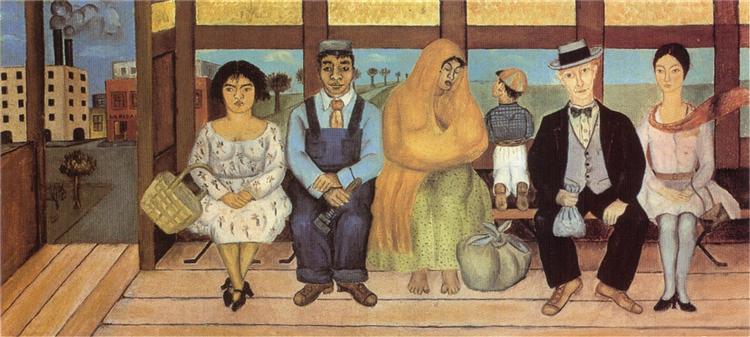
Frida Kahlo "The Bus" (1929)
"The Bus" (1929) captures a seemingly ordinary moment in everyday life, yet it is imbued with Frida Kahlo's keen observation and symbolic depth. This painting portrays a diverse group of individuals seated on a wooden bench of a bus, representing a cross-section of Mexican society. Among the figures, a working man in overalls, a woman holding a baby, an indigenous woman, a schoolboy, and a businessman in a suit, each character offers a snapshot of the varied facets of life in Mexico, highlighting themes of class, culture, and identity.
Kahlo's use of vibrant colors and meticulous detail brings this microcosm of society to life, while the straightforward composition and the direct gaze of some figures toward the viewer invite contemplation of the interconnectedness and shared humanity of these individuals. "The Bus" predates Kahlo's more well-known surrealist and symbolist works, showcasing her early interest in social themes and her ability to find profound significance in the mundane. Through this painting, Kahlo provides a window into the everyday lives of her compatriots, celebrating the diversity and complexity of Mexican society.
9. Self-Portrait As A Tehuana

Frida Kahlo "Self-portrait As A Tehuana" (1943)
"Self-Portrait as a Tehuana" (1943), also known as "Diego on My Mind," is a deeply personal reflection of Frida Kahlo's identity and her tumultuous relationship with Diego Rivera. In this painting, Kahlo adorns the traditional costume of a Tehuana woman, a choice that signifies her embrace of Mexican heritage and her role as Rivera's wife. At the center of her forehead, superimposed on her traditional Zapotec headdress, is a small portrait of Rivera, symbolizing his constant presence in her thoughts and life.
The detailed, folkloric embroidery and the intense, direct gaze of Kahlo confront the viewer with her complex identity as both an artist and a woman deeply intertwined with Rivera. This self-portrait transcends personal narrative, touching on themes of cultural pride, feminine strength, and the indelible impact of love and partnership. "Self-Portrait as a Tehuana" is a testament to Kahlo's profound connection to her cultural roots and her unwavering, albeit complicated, devotion to Rivera.
10. The Wounded Deer

Frida Kahlo "The Wounded Deer" (1946)
The last painting in the list, "The Wounded Deer" (1946) stands as one of Frida Kahlo's most poignant metaphors for her physical and emotional suffering. In this compelling fusion of self-portrait and surreal landscape, Kahlo portrays herself with the body of a deer, pierced by numerous arrows, wandering through a dense forest. The deer's face, bearing Kahlo's own features, looks out with an expression of resigned pain, capturing the artist's chronic agony following numerous medical procedures and her tumultuous personal life.
This painting symbolizes Kahlo's resilience in the face of relentless pain and her identification with nature's vulnerability. The forest setting, both serene and isolating, mirrors her internal landscape of suffering and solitude. Despite the deer's wounds, it stands dignified, embodying Kahlo's enduring spirit and her refusal to be defined by her afflictions.
"The Wounded Deer" reflects Kahlo's mastery of combining personal symbolism with universal themes of suffering and endurance. It is a testament to her ability to convey complex emotional states through powerfully evocative imagery, making it one of her most moving and introspective works.
No Comments Yet...